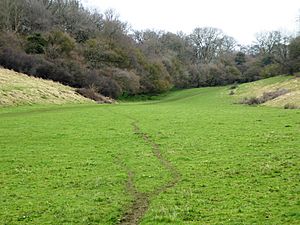Great Shuttlesfield Down facts for kids
| Site of Special Scientific Interest | |
 |
|
| Area of Search | Kent |
|---|---|
| Interest | Biological |
| Area | 21.8 hectares (54 acres) |
| Notification | 1985 |
| Location map | Magic Map |
Great Shuttlesfield Down is a special natural area in Kent, England. It's located north of Folkestone and covers about 21.8 hectares, which is roughly the size of 30 football fields! This area is so important because it's a biological Site of Special Scientific Interest (SSSI). This means it's protected by law because it has rare plants, animals, or unique natural features.
Contents
What Makes Great Shuttlesfield Down Special?
Great Shuttlesfield Down is a fantastic example of unimproved grassland. This means the land hasn't been plowed, fertilized, or changed much by humans. Because of this, it's a perfect home for many different kinds of plants and animals that need this specific environment to survive.
Plants of the Down
The main plants you'll find here are different types of grasses. These include Sheep's fescue, which is a tough grass that can grow in poor soil, and upright brome and tor-grass. These grasses create a thick carpet that's perfect for grazing animals.
Why Grazing is Important
Sheep and cattle often graze on Great Shuttlesfield Down. This might seem simple, but it's actually really important for the grassland! When these animals eat the grass, they help to keep it short and stop bigger, tougher plants from taking over. This allows smaller, more delicate wildflowers and other plants to grow, which in turn provides food and homes for insects.
Amazing Animals You Might Find
Great Shuttlesfield Down is also home to some very special insects, known as invertebrates (animals without a backbone).
The Rare Adonis Blue Butterfly
One of the most exciting creatures here is the rare adonis blue butterfly. This beautiful butterfly has bright blue wings, especially the males, and it loves to live in chalk grasslands like Great Shuttlesfield Down. Its caterpillars feed on a plant called horseshoe vetch, which grows well in this type of habitat. Finding the adonis blue here shows how healthy and important this grassland is.
Solitary Wasps
You might also spot two types of solitary wasps: crossocerus cetratus and crossocerus styrius. Unlike social wasps that live in big colonies, solitary wasps live alone. They don't build large nests or defend them aggressively. Instead, each female builds her own small nest, often in the ground or in plant stems, where she lays her eggs and provides food for her young. These wasps are also a sign of a healthy ecosystem.
Can You Visit Great Shuttlesfield Down?
While Great Shuttlesfield Down is private land, there is a public footpath that crosses the northern part of the area. This means you can still enjoy some of its natural beauty and perhaps spot some of its unique wildlife from the path. Remember to always stick to public paths and respect private property when exploring nature.

